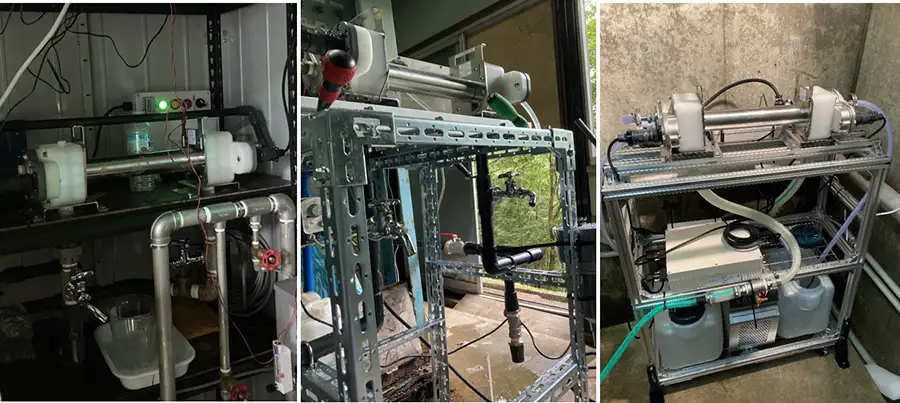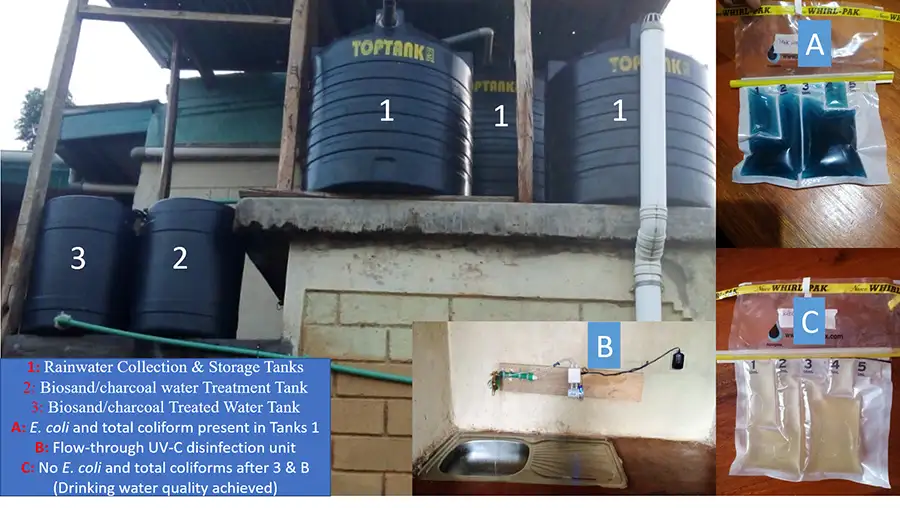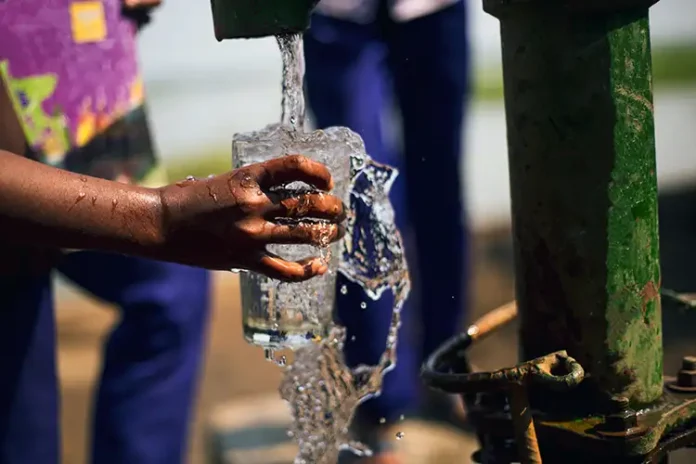By Liz Stevens, writer, UV Solutions
The need for safe, clean, consistently available water grows every day in a world with an increasing population and a dramatically changing climate. UV Solutions caught up with four researchers who made water treatment project presentations at the 2023 IUVA World Congress. The presenters’ projects involved low-pressure UV and UV LEDs for use in India, Japan, Kenya and Uganda, and focused on community knowledge about water quality, as well as disinfection techniques and safe storage methods, field testing for identification of pathogens, proper siting of disinfection technologies for best outcomes, scaling and de-scaling of quartz windows and sleeves, and using biosand and charcoal filters in conjunction with UV LEDs.

Despite the variety of settings, disinfection technologies and system configurations, a common thread permeated the presentations. The following statement from the authors of one highlighted project – Hadas Mamane and Dana Pousty – characterizes their particular beliefs, but it also can stand as a guiding principle for all rural and remote water treatment projects: “The integration of UV disinfection technologies in rural Uganda and India underscores the importance of understanding and adapting to local cultures, attitudes and practices in water treatment. By aligning technological solutions with local needs and behaviors, and through community engagement and education, sustainable improvements in water quality can be achieved, contributing to the broader goal of ensuring safe water access for all.”
UV Solutions wanted to learn more from these presenters about the rural and remote aspects of their UV-facilitated water disinfection projects and share their experiences and findings.
A Laboratory-Derived Snapshot Cannot Depict the On-the-Ground Moving Picture of Pathogens
The World Congress presentation by Kumiko Oguma, professor, Department of Urban Engineering, University of Tokyo, “Demonstration and implementation of a UV LED module at water treatment facilities in remote locations,” revolved around the deployment of water treatment technologies in remote areas of Japan. In Oguma’s experience, UV LED disinfection technology may be a dependable, economical method for decentralized, remote locations but deploying commercial UV LED modules in a remote locale is not always easy. The modules’ performance often has been pre-validated in a laboratory with pure-cultured challenge microorganisms; this is no substitute for the ever-changing array of microorganisms in the field. Oguma found that advance field testing – over an extended period – is recommended to identify the unique, local mix of indigenous microorganisms and to gauge the real-world performance of a chosen disinfection technology, after which suitable water treatment approaches can be tested and evaluated for on-site efficacy.
“I believe any laboratory-based experiments, including validation tests, would not perfectly reflect the real performance in practice, especially in the long term,” said Oguma. “This is not because the test method in the lab is wrong, but simply because the nature in the real world is so complex and unpredictable. I really wanted to learn how UV LED systems might serve the local community in the real world and what challenges might arise to be addressed to better secure public health.”
A one-time, on-site sampling of a water source or a limited-duration field test of equipment is not sufficient, due to a variety of factors. “Learning about the seasonal climate variations and their impact on the source water’s microorganism makeup is one key reason for long-term field testing,” Oguma explained. “Moreover, it already is known that the output power of a UV LED (or any UV lamp) decreases over time. The reactor’s internal wall and quartz window (which delivers UV into the water) can become covered by deposits, such as inorganic scalant and biofilms, reducing the total UV energy emitted for disinfection.” She wanted to observe the UV LED’s energy degradation that inevitably occurs, to identify the local causes of scaling and the likely timetable for recommended maintenance.
In Oguma’s view, another impetus for long-term, on-site evaluation and testing is to pave the way for a positive reception by the local community. “My wish was to let the local people feel confident about their decision about whether or not to implement the technology,” she said. “Water is foundational for daily life and directly related to public health. I wanted to show the community how the technology worked in the long term and let them fully understand how it worked before making their decisions.”
Having validated her belief that long-term field testing is necessary for the successful implementation of water treatment technology in remote settings, Oguma now is preparing for two new UV LED water treatment demonstration studies, one of which will take place in low-income settings in Asia and another to be conducted on aquaculture.
For more information, visit http://www.urbanwater.t.u-tokyo.ac.jp/oguma/en/.
Local Water, Local Mineral Content, Local Fix for Quartz Sleeve/Window Scaling
“Evaluation of Scaling and Fouling in Low-Pressure and UV LED Systems for Use in Rural Communities” was the World Congress presentation from Adefolawe A. Adeyeye, University of British Columbia, and co-authors Paul Nyangaresi and Sara Beck. The presentation focused on techniques for effective descaling and de-fouling of quartz sleeves/windows in rural settings, based on research performed with tap water in the lab at the University of British Columbia. The research produced insight into how scaling and fouling in UV LED and UV low-pressure water treatment systems can degrade the UV energy being emitted and how water treatment users in outlying communities can use economical, readily available remedies to clean the sleeves and windows.

System maintenance is just one aspect of a water treatment technology’s design and implementation that must be crafted with an understanding of the beneficiary population’s culture, its economy and its attitudes clearly in mind. Without regular maintenance, UV-based water treatment efficacy will degrade, no matter the locale. “Scaling is a significant limitation for UV disinfection systems globally,” said Adeyeye. “The quartz sleeve in low-pressure UV systems or the quartz window of UV LEDs can accumulate scaling constituents, such as calcium or magnesium, reducing the dose of UV light that reaches target microorganisms, thus impacting the disinfection process.” Without regular maintenance, including cleaning the quartz component according to manufacturer instructions, a UV system may fail to deliver the necessary UV dose for optimal disinfection. “A reduced UV dose leading to ineffective inactivation of pathogens,” said Adeyeye, “can result in compromised water quality.”
“Local environmental factors – such as water hardness, total dissolved solids (TDS), pH levels and temperature – can lead to increased scaling in UV-driven water treatment systems,” Adeyeye explained. Water analyses conducted before implementing urban or municipal UV treatment systems typically test for those environmental factors to assess the potential impact on scaling. “But due to limited resources in many rural communities,” said Adeyeye, “the water analyses often only focus on the microbial quality of the drinking water. Factors such as flooding, erosion, heavy rainfalls and wildfires, however, also can influence source water quality, increasing its turbidity, which, if not addressed, may contribute to scaling in UV treatment systems.”
The standard remedy for descaling is laboratory-grade citric acid, which may be difficult to obtain in some settings. “Sourcing citric acid may pose challenges in rural communities,” Adeyeye said. “The difficulty in finding laboratory-grade citric acid is compounded by its expense, even if it is available. In such cases, alternative cleaning agents may be more commonly used, depending on local availability and cost-effectiveness.” Adeyeye’s research showed that a simple, inexpensive and generally widely available fix of lime and lemon juice can work as a substitute for citric acid. “The lime and lemon juice work based on the constituents in the water, and these constituents differ from location to location,” said Adeyeye. “From my experiments, I found that undiluted lime and lemon juice are effective in the removal of scaling due to calcium and magnesium. They are not so effective, however, in the removal of iron and manganese scaling.” The time required for this simple method for descaling with lime and lemon juice varies, depending on the severity of scaling in the UV system and the mineral constituents responsible, but is on the order of hours.
Following the World Congress presentation, Adeyeye changed her thesis title to “Evaluation of Scaling and Scaling Reversal in UV Systems for Application in Rural Communities” since her focus was on scaling and not the fouling aspect of the presentation topic.
For more information, visit www.becklabubc.com.
For Project Success, Know the Local Culture, the Seasonal Water Sources and the Varying Pathogens
“Design and field-testing of a biosand/charcoal and gravity-driven flow-through UV-C LED system for treating harvested rainwater in a marginalized rural community, Kenya,” was presented by Paul Onkundi Nyangaresi, postdoctoral researcher, University of British Columbia – Canada, and his co-authors Patrick N. Mirindi, Adefolawe A. Adeyeye, Richard M. Mariita and Sara E. Beck. In a Kisii County, Kenya, research project using rainwater harvested from roofs, and employing biosand/charcoal filtering and gravity-driven flow through UV-C LED reactors, the researchers found that the biosand/charcoal aspect was useful for lessening odor, clearing turbidity and adjusting pH. They also found that UV-C LED as a subsequent treatment step was necessary to ensure reliable pathogen elimination.
In this rural-based project, unknown characteristics of the weather patterns and the enigmatic culture of the community could have hampered the success of the water treatment system implementation. The project was fortunate, though, to have Nyangaresi on board; he was born and raised in the area and was steeped in local knowledge. But although Nyangaresi was known to the community and had deep insights – which gave the research team a leg up – gaining the trust of the local community still required diplomacy and advocacy.

Addressing the local water users’ inaccurate perception that untreated rainwater was a clean, healthy water source presented an opportunity for diplomacy. In this locale, the presence and concentration of E. coli and total coliforms vary dramatically depending on the point of water collection and the season; rainwater is hardly trustworthy as being clean or healthy. Nyangaresi’s knowledge of water-based pathogens gave him an array of hard scientific facts, and his intimate knowledge of local culture gave him insight into the reasons behind the faulty view of harvested rainwater. That combination, along with a smart choice of water quality demonstrations, brought home the important truth about harvested rainwater.
“My goal,” said Nyangaresi, “was to convince the community that the quality of the rainwater was not good. We brought in the science aspect because, for this community, the long-held way to judge water quality was with their eyes. If they see that the color is good, they assume the water is clean. Or maybe they look at the color and check for particles – dissolved particles – and also check for an odor.” The community, though, might rely only upon those inconclusive characteristics. “If the water is very clear and there is no smell,” he explained, “the people might still say this is very good water.”
“What they don’t understand,” Nyangaresi continued, “is that there are microorganisms which we cannot see or smell. That is why we bring in science.” Water test kits with a visual quality indicator – a change of color – are easy to see and interpret. “One can bring a sample of water, and then use the color-change test kit. With E. coli, for example, the indicator color changes from yellow to blue in the presence of E. coli. The test kits should be simple so that the people can interpret the result by themselves. They do not need an in-depth understanding; they only need to know that if the color changes from this to this, it means this; and if there is no color change, it means something else.” When Nyangaresi displayed test results to the Kisii County community that clearly showed that harvested rainwater was a contaminated source, the community was convinced by the dramatic color change.
Nyangaresi credits his deep connection to and knowledge of Kisii County as a hard-to-overstate factor in the success of the water treatment project. He described the advantages of being in tune with the local population. “To design any system,” said Nyangaresi, “whether it is municipal or in a rural or marginalized area, you have to be able to communicate. But it is much easier to do a project if you come from the region; you understand who is who, and even what they do for a living.”
Nyangaresi knows that Kisii County is an agricultural area, and he knows its weather. “I know when it rains,” he said, “and I know when it does not. I know where these people normally get their water. I know the quality of different water sources, and I know the challenges people go through when they are in need of water.” The area sees a pattern of long rains falling from the end of February to June, and short rains from August to November. In contrast, January and July are quite dry. With his understanding of the rainfall pattern, Nyangaresi knew that a combination of age-old but effective pre-treatment methods, hygienic water storage management and a new water treatment system would have to be carefully coordinated and consistently used to provide safe water across the rainy and dry periods.
Nyangaresi now hopes to improve the Kisii water treatment system by adding solar energy for backup electricity and by installing a larger UV-C LED system with a higher flow rate. He also is collaborating with colleagues in the industry to set up a water treatment system for a nearby school, the Rianyabayo Memorial Academy.
For more information, visit https://www.becklabubc.com/our-team/paul-nyangaresi.
Installing a Water Treatment System – Integration Beats Imposition
At the World Congress, Hadas Mamane, head of Environmental Engineering Program, Tel Aviv University, presented “Considerations for Implementing UV Disinfection Technologies in Rural Areas” on behalf of herself and co-authors Dana Pousty, Igor Donsky, Vered Cohen, Yifaat Bezalel, Suzan Kagan, et al. Mamane and her team undertook research projects to set up and field test UV LED disinfection technologies in rural areas of India and Uganda, using 2 L/min wired devices for household point-of-use disinfection and 15 L/min solar-powered reactors at community scale. Among other insights, the researchers learned that an appreciation of the local culture was crucial to each project’s success, as was an implementation framework that integrated new water treatment methods into the existing infrastructures rather than imposing completely new technologies onto a community.
In the India-based project, Mamane field tested a household UV LED water treatment solution tailored for rural settings. “The focus was on integrating UV devices on the taps of household water containers,” Mamane explained. “Given the region’s intermittent electricity, this project aimed to provide a point-of-use treatment solution that would fit the local context and consumption patterns.” In the case study, the researchers learned that the local community stored household water in various types of unmaintained containers, a practice with significant re-contamination risks, even for clean and fresh water sourced from the community’s reverse osmosis treatment facility. “This insight was crucial in developing a UV LED system that could be integrated with household water containers (and with the users understanding the need for consistent cleaning and maintenance),” said Mamane, “to ensure that the water remained safe even after in-home storage.”
“In the India project, “said Mamane, “women were trained as ‘water ambassadors’ to monitor water quality in their communities. The level of education and technical knowledge in rural communities can be a barrier to the effective use and maintenance of new systems. Our studies highlighted a disparity in the perception of water safety and quality between the trained women (water ambassadors) and the residents.” Mamane recounted discrepancies in reporting water container volumes and the conditions of water storage, which could lead to misunderstandings or mistrust of the system’s effectiveness. “In these situations,” Mamane said, “overcoming negative impacts required tailored approaches that considered local culture, education levels and technology literacy. Effective training, clear communication about the benefits of the treatment system, and engagement with community leaders to foster trust and acceptance were crucial.”
In Uganda, Mamane implemented a community UV LED water disinfection system, tapping into a village’s solar-powered water infrastructure – which provided only intermittent electrical power – to provide consistent access to disinfected water. “The community’s reliance on community taps highlighted a culture adapted to intermittent water availability,” Mamane explained. “Integrating UV technology into the existing water practices was essential to ensure acceptance. By aligning the technology with existing behaviors, such as using community taps and solar power, the solution was more readily adopted and sustained by the villagers.”
In both projects, cultivating community engagement was vital to raise awareness about water safety, to point out the hazards of contaminated water, to convey the anticipated costs (financial and otherwise) required for providing clean water and to emphasize the value derived from a consistent supply of safe water.
Mamane and Pousty are establishing a nonprofit initiative, SOLED, to provide safe drinking water to low-income countries, with a special emphasis on rural, remote and flood-prone areas. “The initiative approach,” said Mamane, “is tailored to meet the challenges of areas with limited resources, emphasizing adaptability and sustainability. The grand vision of SOLED involves a repeatable method for researching, developing and implementing sustainable water disinfection solutions.”
For more information, email hadasmg@tauex.tau.ac.il.






